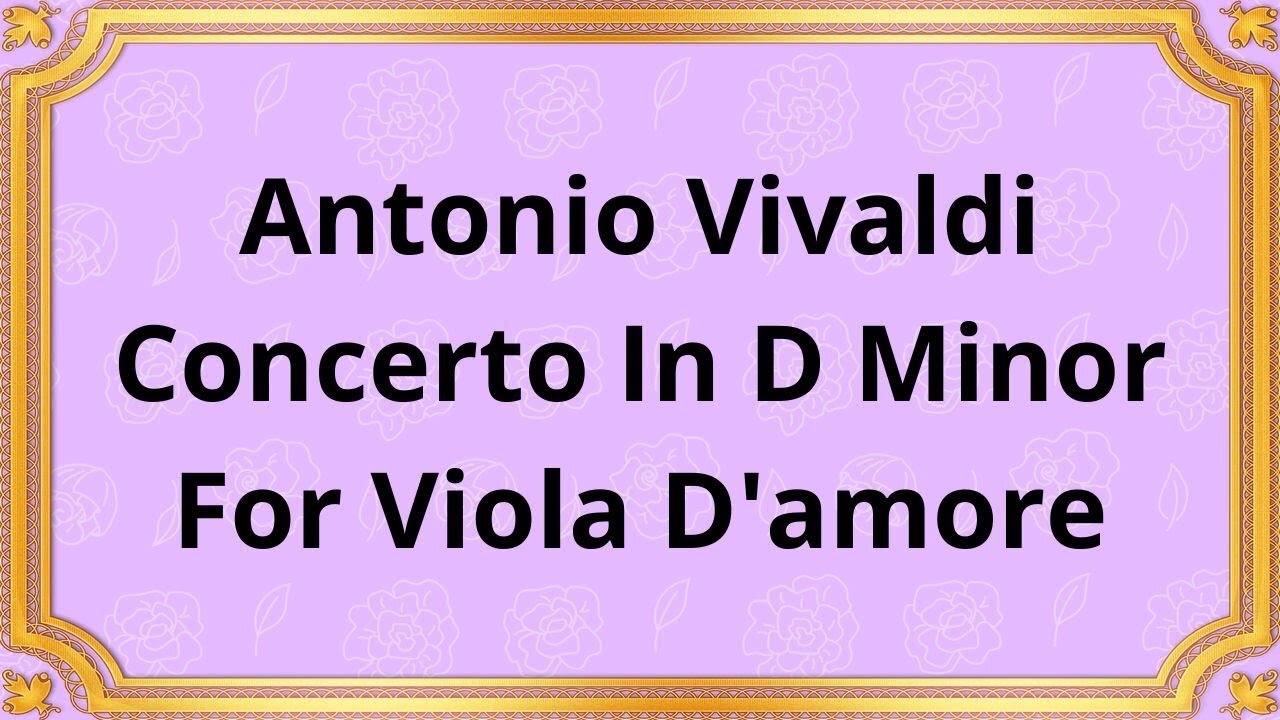Premium Only Content

Antonio Vivaldi Concerto In D Minor For Viola D'amore
#AntonioVivaldi #Concerto #ViolaDamore #ClassicalMusic #BaroqueEra #MusicalComposition #OrchestralMusic #StringInstruments #ItalianComposer #SoloInstrument #StringOrchestra #MelodicBrilliance #ExpressivePhrasing #VirtuosicPassages
Publication date 1950
RENZO SABATINI, VIOLA ANTHONY BERNARD conducting the LONDON CHAMBER ORCHESTRA
Antonio Vivaldi, a prominent Italian composer of the Baroque era, left an indelible mark on classical music with his numerous concertos. Among his exceptional works stands the Concerto in D Minor for Viola d'amore, a composition that showcases Vivaldi's innate ability to create captivating melodies and exploit the expressive potential of the viola d'amore.
Antonio Vivaldi composed the Concerto in D Minor for Viola d'amore during the early 18th century. This period witnessed a flourishing of instrumental music, and Vivaldi played a pivotal role in shaping the concerto form with his innovative compositions.
The viola d'amore, a string instrument popular during the Baroque period, takes center stage in Vivaldi's concerto. Known for its resonant and warm tone, the viola d'amore adds a unique timbral quality to the composition. The soloist, with their virtuosic command of the instrument, brings Vivaldi's melodies to life with expressive phrasing and technical prowess.
The concerto follows the typical three-movement structure of Baroque concertos:
a. Allegro: The concerto opens with a lively and dramatic movement characterized by fast tempos, intricate ornamentations, and virtuosic passages. The viola d'amore engages in a spirited dialogue with the accompanying string orchestra, showcasing its melodic brilliance.
b. Largo: The second movement contrasts the exuberant energy of the first with a lyrical and introspective section. Vivaldi's sensitive writing allows the viola d'amore to express its plaintive and expressive qualities, captivating listeners with its emotional depth.
c. Allegro: The final movement returns to a lively tempo, featuring spirited and energetic exchanges between the soloist and the orchestra. Vivaldi's masterful composition keeps the listener engaged with its rapid-fire passages and rhythmic vitality.
Vivaldi's Concerto in D Minor for Viola d'amore exemplifies his gift for crafting memorable melodies. The composition is replete with enchanting and memorable themes that highlight the instrument's unique timbre. Vivaldi's use of ornamentation and expressive phrasing further enhances the emotional impact of the music, captivating the listener's imagination.
Vivaldi's Concerto in D Minor for Viola d'amore holds a significant place in the repertoire of Baroque music. Its melodic brilliance, expressive qualities, and virtuosic demands have made it a favorite among viola d'amore players and enthusiasts alike. The composition not only showcases Vivaldi's mastery as a composer but also highlights the expressive potential of the viola d'amore as a solo instrument.
Conclusion:
Antonio Vivaldi's Concerto in D Minor for Viola d'amore stands as a testament to the composer's genius and his ability to create breathtaking melodies. Through its three movements, the concerto takes listeners on a journey of emotional depth, from lively and energetic passages to introspective and heartfelt moments. The virtuosic demands placed on the viola d'amore and the melodic brilliance of the composition ensure its enduring popularity and its place among the treasured works of the Baroque era.
You have the opportunity to support the channel:
https://destream.net/live/RadSiarAl/donate
https://www.buymeacoffee.com/6355radsiaral
-
 20:26
20:26
Classical music_Music Inspiration
1 month agoJohann Sebastian Bach Orchestral Suite No. 2 in B minor, BWV 1066
862 -
 LIVE
LIVE
Anthony Rogers
1 day agoEpisode 376 - Todd Schowalter
76 watching -
 LIVE
LIVE
megimu32
2 hours agoOTS: Movie Tie-In Games + Remakes: Let’s Play Memory Lane
125 watching -
 DVR
DVR
Adam Does Movies
10 hours ago $0.18 earnedTalking Movies + Ask Me Anything - LIVE
6.19K -
 1:17:18
1:17:18
Glenn Greenwald
1 day agoWhat are CBS News' Billionaire Heirs Doing with Bari Weiss? With Ryan Grim on the Funding Behind It; Europe Capitulates to Trump Again | SYSTEM UPDATE #494
94.4K63 -
 1:43:49
1:43:49
RiftTV
4 hours agoCNN Calls Black NY Shooter WHITE, Cincinnati FATIGUE | The Rift | Guest: Braeden Sorbo, 2Protects1
37K14 -
 4:21:04
4:21:04
LumpyPotatoX2
5 hours agoKilling Floor 3: Rampage & Chaos - #RumbleGaming
9.85K -
 LIVE
LIVE
BrancoFXDC
5 hours ago $0.51 earnedPlaying Ranked Warzone - Pursuit of Diamond Rank
95 watching -
 1:11:41
1:11:41
Omar Elattar
5 hours agoThe Brain Experts: "Your Overthinking Problem Has A Physical Solution & We Can Show You!"
13K1 -

Mattnifico
4 hours agoREPLAYING EVERY FORZA HORIZON GAME - Forza Horizon 1 (Part 2)
4.43K